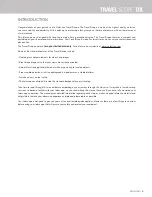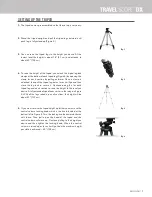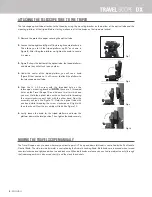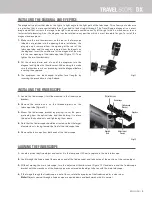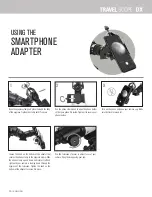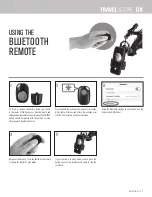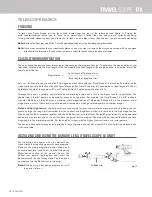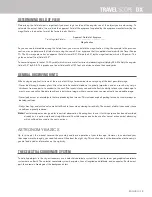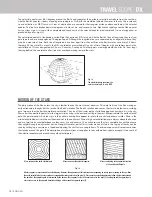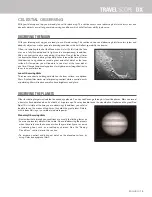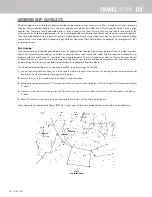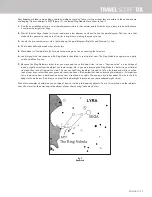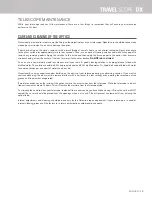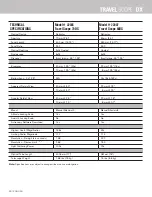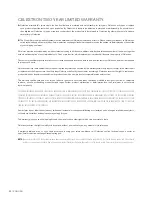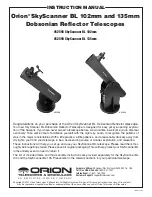
12
I
ENGLISH
TELESCOPE BASICS
FOCUSING
To focus your Travel Scope turn the focus knob located near the rear of the telescope (see Figure 1) Turning the
knob counterclockwise allows you to focus on an object that is farther than the one you are currently observing
Turning the knob clockwise from you allows you to focus on an object closer than the one you are currently observing
Note:
Remove the front lens cap of the Travel Scope optical tube prior to attempting your observation
Note:
If you wear corrective lenses (specifically glasses), you may want to remove them when observing with an eyepiece
attached to the telescope If you have astigmatism, corrective lenses should be worn at all times
Focal length of Telescope (mm)
Magnification
=
_____________________________
Focal length of Eyepiece (mm)
INSTALLING AND USING THE BARLOW LENS (TRAVEL SCOPE 60 ONLY)
Let’s say, for example, you are using the 20mm eyepiece that came with your Travel Scope 70 telescope To determine the
magnification you divide the focal length of your telescope (the Travel Scope for this example has a focal length of 400mm)
by the focal length of the eyepiece, 20mm Dividing 400 by 20 yields a magnification of 20x
Although the power is variable, every telescope under average skies has a limit to the highest useful magnification The
general rule is that 60 power can be used for every inch of aperture For example, the Travel Scope 70 is 2 8” inches in
diameter Multiplying 2 8 by 60 gives a maximum useful magnification of 168 power Although this is the maximum useful
magnification, most of your observing will be done at low powers which generate brighter and sharper images
Note on Using High Powers–
Higher powers are used mainly for lunar and sometimes planetary observing where you can
greatly enlarge the image, but remember that the contrast and brightness will be very low due to the high magnification
When using the 8mm eyepiece together with the 3x Barlow lens with the Travel Scope 60 gives extremely high power and
can be used on rare occasions – you will achieve the power but the image will be dark with low contrast because you have
magnified it to the maximum possible For the brightest images with the highest contrast levels, use lower powers
You can purchase optional eyepieces to give you a range of powers you can observe with Visit the Celestron website to see
what is available
Your telescope also comes with a 3x Barlow Lens
which triples the magnifying power of each eyepiece
However, the greatly magnified images should only
be used under ideal conditions – see the Calculating
Magnification section of this manual To use the
Barlow lens remove the diagonal and insert the
Barlow directly into the focuser tube You then insert
an eyepiece into the Barlow lens for viewing
Note:
Start by using a low power eyepiece as it will
be easier to focus
CALCULATING
MAGNIFICATION
You can change the power of your telescope just by changing the eyepiece (ocular) To determine the magnification of your
telescope, simply divide the focal length of the telescope by the focal length of the eyepiece used In equation format, the
formula looks like this:
3x Barlow Lens
Fig. 13
Summary of Contents for 22007
Page 1: ...INSTRUCTION MANUAL Models 22007 60 DX 22035 70 DX ENGLISH DX ...
Page 2: ......
Page 4: ...4 I ENGLISH ...
Page 21: ...ENGLISH I 21 NOTES ...
Page 24: ...MANUEL DE L UTILISATEUR Modèle n 22007 60 DX n 22035 70 DX FRANÇAIS LONGUE VUE DE VOYAGE ...
Page 25: ......
Page 27: ...4 I FRANÇAIS ...
Page 44: ...FRANÇAIS I 21 NOTES ...
Page 47: ...BEDIENUNGSANLEITUNG Modell 22007 60 DX 22035 70 DX DEUTSCH REISETELESKOP ...
Page 48: ......
Page 50: ...4 I DEUTSCH ...
Page 67: ...DEUTSCH I 21 HINWEISE ...
Page 70: ...MANUALE DI ISTRUZIONI Modello n 22007 60 DX n 22035 70 DX ITALIANO TELESCOPIO DA VIAGGIO ...
Page 71: ......
Page 73: ...4 I ITALIANO ...
Page 90: ...ITALIANO I 21 NOTE ...
Page 93: ...MANUAL DE INSTRUCCIONES Modelo Nº22007 60 DX Nº22035 70 DX ESPAÑOL TELESCOPIO PARA VIAJES ...
Page 94: ......
Page 96: ...4 I ESPAÑOL ...
Page 113: ...ESPAÑOL I 21 NOTAS ...





